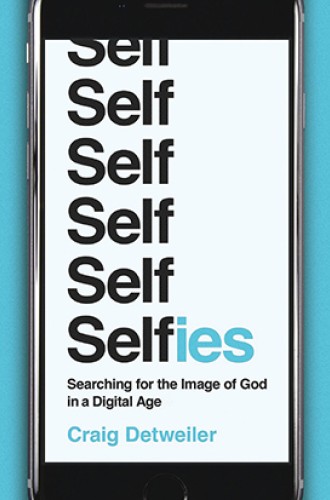Seeing the image of God in our selfies
Craig Detweiler draws on art history, psychology, and religion to argue that staring at ourselves can be an act of faith.
More than a billion phones contain Meitu apps that make it possible for selfie-takers to erase imperfections, get flawless skin, and affix to themselves blossoms and kitty ears. Investigating “China’s selfie obsession” for the New Yorker, Jiayang Fan spoke to Meitu’s founder who told her, “In the same way that you would point out to your friend if her shirt was misbuttoned, or if her pants were unzipped, you should have the decency to Meitu her face if you are going to share it with your friends.” Fan discovered that this comment was not just product promotion. It’s common for Chinese selfie-takers to spend 40 minutes or more using a product like Meitu to doctor their selfies.
Fan’s article was still in my ears when I read Craig Detweiler’s exploration of selfies as a form of digital discipleship. “Rather than seeing selfies as the problem, I approach selfies as the start of a solution,” he writes. “Selfies are a search for God via God’s image: us. . . . Our selfies can be redeemed. May we cast aside our old, manic, false selfies in order to put on a new selfie, in Christ and for the community.”
Read our latest issue or browse back issues.
The author of iGods and Into the Dark and president of the Seattle School of Theology and Psychology, Detweiler is a sympathetic observer of the media landscape. He does raise questions about the danger of selfies, discussing the emotional and spiritual risks that go along with what Erving Goffman called “impression management.” Detweiler also cautions readers about the way that social media lends itself to the type of public piety against which Jesus warns us (#blessed), and he acknowledges the risk that selfies, Instagram posts, and Snapchat stories place one’s identity in the hands of others. “Overcoming our self-seeking instincts isn’t easy, especially when so many social-media prompts encourage us to think about me, rather than we, first,” he acknowledges as he admits that the selfie is a limited medium.
But his overall perspective on selfies is optimistic. If taken and viewed reflectively, even sacramentally, Detweiler claims, selfies can become a medium by which we experience God’s image in ourselves and others. “We need to see through the image that others are projecting,” he urges, “to recognize the cry of the heart residing behind the Gram or the Snap.”
Detweiler creates a lively bricolage of history, mythology, portraiture, photography, autobiography, psychology, and the ancient church. He encourages a re-reading of the myth of Narcissus, suggesting that a two-dimensional reading of the myth has led to simplistic critiques of adolescent culture as narcissistic. “Studying ourselves, taking stock of our lives, need not be inherently sinful,” he writes. “Staring at our reflection need not be dangerous when the pool is God.” He traces a long tradition of self-portraiture dating back to at least the Renaissance, naming artist Jan van Eyck’s 1433 Portrait of a Man as the ur-selfie (although Paleolithic cave drawings of humans might better claim that distinction). Detweiler’s dance through art history—including the work of Frida Kahlo, who he says “has shown us how powerful and profound even the most deeply personal selfies can be”—makes a case that selfies exist within a wide cultural matrix.
Detweiler labors to cinch together ideas and realities that may at first appear distant from each other: the selfie and Renaissance art, self-promotion and self-awareness, profane and sacred, snapping photos and deepening one’s spirituality. I find his impulse to redeem rather than berate an admirable one, and it opens up a range of interdisciplinary intrigue.
Yet connecting disparate items can exact a cost. While it’s intellectually intriguing to consider what Parmigianino’s 1524 painting Self-Portrait in a Convex Mirror has in common with, say, my young friend’s selfie from a cruise ship, claiming commonalities risks erasing critical elements of both. It’s true that both involve youth experimenting with “their looks, their self-image, their public presentation.” But the former involves artistry, discipline, and a proficiency born of hours of devotion to a craft, while the latter—well, doesn’t.
Detweiler’s frequent rhetorical questions disclose a somewhat Pollyanna hopefulness. “Could selfie making lead to a revival of contemplation, a rediscovery of self-reflection rooted in prayer?” he asks. It doesn’t take a selfie skeptic to question the likelihood of that scenario. And the “selfie challenges” at the end of each chapter, which encourage readers to practice viewing the world and themselves in more sacramental ways, seem ill-fitting. Chapter 1: “Get started by taking a selfie to give God a status update on you. Try to communicate your feelings without a smile.” Chapter 8: “Look into the lens as if you’re gazing into the loving eyes of Jesus. Now snap.”
As an editor, I understand the rationale behind providing a practical tip or list of takeaways. But the selfie challenge assignments, as well as the imperative voice that punctuates the text, suggest an ambivalence about audience. Is Selfie aimed at selfie-takers themselves, to affirm and deepen their practices? Or is it an apology for the medium directed at folks like me, who have never posted a selfie and remain dubious about their value?
Detweiler’s ire seems reserved for critics, presumably older ones, who label selfie-taking millennials as egoistic, narcissistic, and lacking in decorum. While he himself offers cautions about selfies, he suggests that others who do so may be leveling critique from a place of privilege—people who prefer that self-portraiture remain the domain of the privileged classes. “Is the backlash against them [selfies] a way to disempower those who finally have the ability to craft their own images?” he asks, elsewhere answering his own question: “Our discomfort and even outrage toward selfies may stem from remnants of these social standards regarding who is worthy to be photographed and displayed.”
I agree that knee-jerk criticism of popular culture products often drips with racial or class privilege. But I’m not sure what distinguishes the author’s own caveats about selfies from the “backlash” from which he distances himself. Fan’s New Yorker article, for example, which reports on a culture in which unaugmented selfies are considered uncouth, represents not backlash but incisive critique. The consequences of such a culture—in which it becomes imperative that the imago dei be toned, smoothed, filtered, and cutified—are problems with which Detweiler does not adequately reckon.
Yet while I muttered a steady string of complaints throughout the pages of Selfie, I found it a provocative and animated read, full of invitations—some more convincing than others—to reconsider my own wariness of the form. For selfie-taking and selfie-viewing pastors, teachers, and counselors, his approach is more practical and helpful than a screed against them could ever be. Indeed, the author’s Kuyperian vision—that over every single inch of selfiedom Christ reigns—has altered my vision and quieted at least a portion of my critical spirit.
As I finished the book, my 15-year-old showed me a selfie he took at a youth retreat. He and a friend had just returned from a night hike to the top of Peters Mountain, a forested ridge that abuts the camp. Light from a nearby cabin just off the left edge of the frame partially illumines his face, creating a chiaroscuro of such vividness and depth that I gasped. That implausible image in Matthew 17—the “bright cloud” overshadowing the transfigured Christ—made sudden sense. Lips slightly parted, his face a luminous play of light and shadow, my son’s face is transformed.
Some truth is disclosed here, some radiance revealed. I look at this image often, seeking but not yet finding words.
A version of this article appears in the print edition under the title “Selfies and the sacred.”






